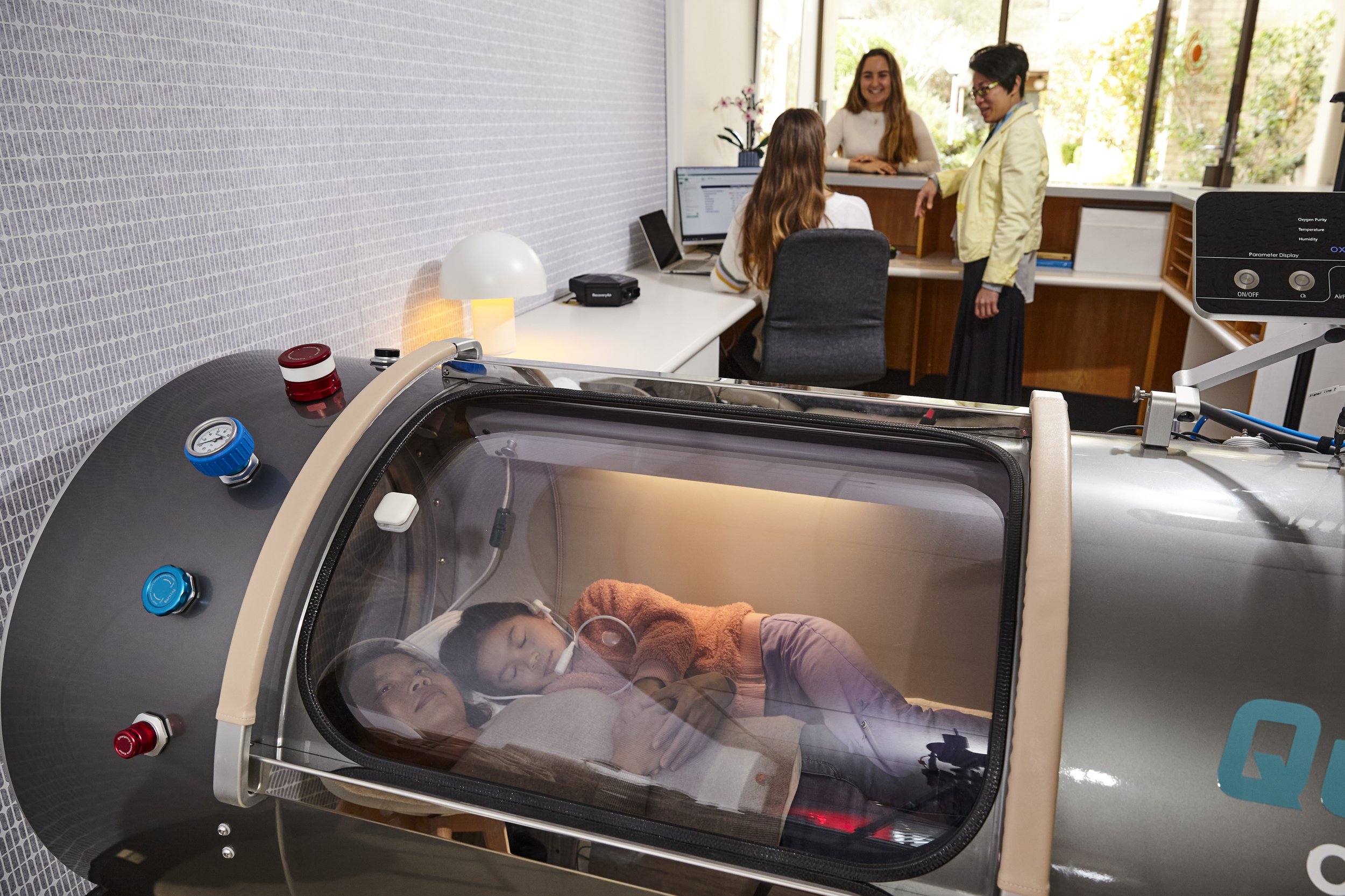
Hyperbaric Oxygen Therapy (HBOT)
Hyperbaric Oxygen Therapy (HBOT), is a revolutionary treatment that immerses you comfortably in life-sustaining, cell-nourishing, and energy-producing oxygen. By selectively targeting free-radicals, HBOT helps prevent cellular degeneration.
HBOT is a valuable treatment utilized in major hospitals and wound care centers for tissue healing. It's also employed as an emergency medical treatment for life-threatening conditions such as deep-sea diving accidents.
What to expect:
Session: You'll enter a specialized hyperbaric chamber, where the atmospheric pressure gradually increases to levels higher up to 1.8 ATA. You'll be laying down while breathing pure oxygen delivered through a oxygen headpiece. During the increase and decrease in pressure, equalizing ear pressure exercises are recommended.
Monitoring: Throughout the session, our trained staff closely monitor your well-being to ensure a safe and effective treatment experience.
Duration: HBOT sessions typically last 60 minutes, during which time you can rest, read, or listen to music. Duration may be variable according to your individualized protocol.
HBOT's Therapeutic targets
Improving Energy Levels, Strength and Sleep Patterns:
HBOT provides the body with an extra-large dose of oxygen, facilitating additional energy production within metabolically-active cells and tissues. This boost in cellular energy can combat age-related diseases by improving ATP utilisation, aiding in tissue repair and cellular function. It can enhance physical performance and stamina and may help combat fatigue and promote better sleep quality.
Regenerating Tissue:
HBOT facilitates the body's ability to produce new tissue and blood vessels, essential for healing injuries and combating degenerative effects of aging. It stimulates fibroblast activation for collagen production and mobilizes stem cells for tissue regeneration, including neurogenesis following brain injuries and osteogenesis. By providing your cells with an extra dose of oxygen, HBOT accelerates the healing process, making it particularly beneficial for tissue repair and wound healing.
Reducing Inflammation:
HBOT significantly reduces swelling and inflammation, crucial for both acute and chronic inflammatory disorders. By constricting blood vessels and lowering inflammatory markers, HBOT aids in the repair of damaged tissues and can alleviate associated pain, particularly in inflammatory-related pain disorders.
Enhancing Immune Function:
HBOT influences immune function by improving phagocytosis and apoptosis, aiding in infection control and resolving inflammation. It also boosts the body's antioxidant system, providing cellular protection against stressors and promoting overall health.
Relieving tension and stress:
HBOT helps promote relaxation and reduce stress levels, allowing your body to heal and recover more effectively. Repeated exposures of HBOT have been shown to cause a strong parasympathetic response. This is the part of the nervous system responsible for rest, digestion, and repair.
Possible risks and contraindications:
HBOT potential contraindications: untreated pneumothorax, certain types of chemotherapy, severe chronic obstructive pulmonary disease (COPD), recent ear or sinus surgery, blocked nose or ears/ inability to equalise pressure, high fever, certain seizure disorders, optic neuritis, and severe claustrophobia.
HBOT carries potential risks and side effects, which may include, but are not limited to, ear or sinus pain, temporary vision changes, lung collapse (pneumothorax), oxygen toxicity, and, in rare cases, seizures. Users should discuss these potential risks with their provider before commencing treatment.
IBUM Certified Intermediary Hyperbaric Technician on site.
For more information:
https://hyperbaricexperts.com/benefits/physiological-benefits/
https://hyperbaricexperts.com/benefits/reported-benefits/
https://hyperbaricexperts.com/latest-research/
Ortega MA, Fraile-Martinez O, García-Montero C, et al. A General Overview on the Hyperbaric Oxygen Therapy: Applications, Mechanisms and Translational Opportunities. Medicina (Kaunas). 2021;57(9):864. Published 2021 Aug 24. doi:10.3390/medicina57090864 https://www.ncbi.nlm.nih.gov/pmc/articles/PMC8465921/
Lindenmann J, Porubsky C, Okresa L, et al. Immediate and Long-Term Effects of Hyperbaric Oxygenation in Patients with Long COVID-19 Syndrome Using SF-36 Survey and VAS Score: A Clinical Pilot Study. J Clin Med. 2023;12(19):6253. Published 2023 Sep 28. doi:10.3390/jcm12196253 https://pubmed.ncbi.nlm.nih.gov/37834897/
Mrakic-Sposta S, Vezzoli A, Garetto G, et al. Hyperbaric Oxygen Therapy Counters Oxidative Stress/Inflammation-Driven Symptoms in Long COVID-19 Patients: Preliminary Outcomes. Metabolites. 2023;13(10):1032. Published 2023 Sep 25. doi:10.3390/metabo13101032 https://pubmed.ncbi.nlm.nih.gov/37887357/
El Hawa AAA, Bekeny JC, Phillips NW, Johnson-Arbor K. Hyperbaric oxygen therapy for paediatric patients: an unintended consequence of the COVID-19 pandemic.J Wound Care. 2021;30(Sup9):S24-S28. doi:10.12968/jowc.2021.30.Sup9.S24 https://pubmed.ncbi.nlm.nih.gov/34554855/
Cannellotto M, Yasells García A, Landa MS. Hyperoxia: Effective Mechanism of Hyperbaric Treatment at Mild-Pressure. Int J Mol Sci. 2024;25(2):777. Published 2024 Jan 8. doi:10.3390/ijms25020777 https://pubmed.ncbi.nlm.nih.gov/38255851/

